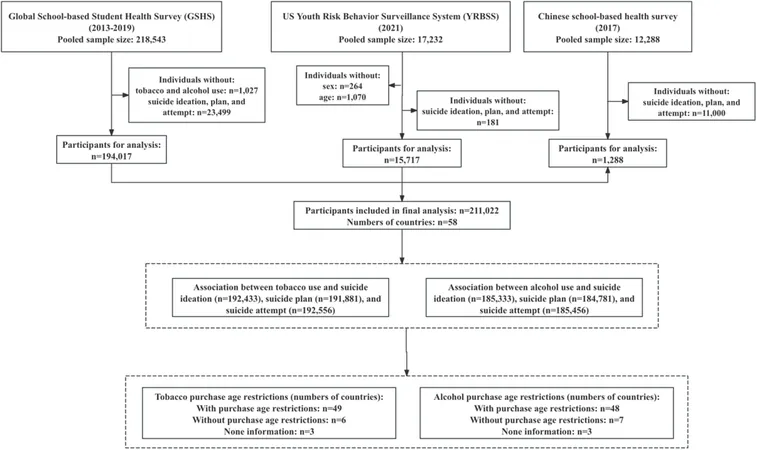
A Global Perspective on Adolescent Suicide Risk: The Harrowing Links Between Tobacco, Alcohol Use, and Legal Age Restrictions
2025-03-18
Author: Jia
Introduction
Suicidal behaviors, including ideation, planning, and attempts, tragically rank as the leading cause of death and disability among adolescents around the globe. Despite the Sustainable Development Goals (SDGs) urging nations to promote well-being and reduce premature mortality from non-communicable diseases by one-third before 2030, the reality remains grim as we approach the halfway mark to these targets. The global situation continues to deteriorate, potentially worsening in the wake of the ongoing pandemic.
Substance Use and Suicide Risk
Recent research pinpoints substance use—particularly tobacco and alcohol—as critical factors associated with suicidal behaviors among adolescents in both affluent and low/middle-income nations. Alarmingly high rates of tobacco and alcohol consumption coincide with increased risks of suicide attempts and ideation. In one study, Chinese and U.S. adolescents aged 7 to 12 who reported using these substances displayed heightened risks of suicidal thoughts and actions. Another study documented that adolescents aged 12 to 18 with alcohol use disorders were 18% more likely to require hospitalization due to suicide-related issues.
Legal Age Restrictions and Their Impact
Although it’s clear that substance use is a significant risk factor, a research gap remains regarding how tobacco and alcohol use interact with suicidal behaviors globally. The legal systems of various countries have aimed to combat these issues through age restrictions on the purchase of tobacco and alcohol products, with the hope of mitigating associated health risks, including self-harm.
A recent meta-analysis revealed that limiting alcohol access significantly correlated with reduced self-harm suicide attempts amongst adolescents. In the U.S., raising the minimum drinking age appeared linked to declines in adolescent suicides. However, the extent of effectiveness of these legal age restrictions varies significantly around the world, raising questions about their efficacy.
Study and Findings
To bring clarity to this pressing issue, a pooled analysis was conducted involving data from over 211,000 adolescents across 58 nations. Utilizing a structured method, researchers delved into the relationships between substance use and suicidal ideation, planning, and attempts, all while examining the influence of existing age restrictions.
The datasets analyzed included findings from school surveys such as the U.S. Youth Risk Behavior Surveillance System (YRBSS) and the Global School-based Student Health Survey (GSHS).
Key observations from the analysis revealed that: - Overall, the prevalence of suicide ideation stood at 14.9%, with planning at 13.5%, and attempts at 11.1%. - Adolescents who used tobacco reported rates for suicidal ideation, plans, and attempts as high as 36.9% compared to 29.0% for girls, while alcohol users displayed rates of 41.7% and 42.7%, respectively. - The odds of experiencing suicidal thoughts and actions were notably elevated for those who used both substances.
Mixed Landscape of Age Restrictions
The effectiveness of age restrictions also presented a mixed landscape. In countries that enforced age limits on tobacco sales, the odds of suicide behavior were notably lower than in countries without such restrictions—indicating potential protective benefits from these policies.
Despite these encouraging findings, the study underscored critical disparities among vulnerable populations. Notably, girls generally exhibited more considerable odds of suicidal behaviors connected to substance use compared to boys, suggesting the urgent need to customize intervention strategies for different demographics.
Toward a Healthier Future: Recommendations
As the findings suggest, both tobacco and alcohol use present significant risk factors for suicidal behaviors in adolescents. Thus, effective age restrictions on tobacco purchases seem essential in mitigating these risks, particularly in regions with high rates of suicide. However, alcohol restrictions do not appear to exhibit the same protective effects—indicating an area for further inquiry.
Going forth, fostering comprehensive interventions, including education and mental health services, will be vital in preventing adolescent suicides. Addressing the roots of substance use and suicidal ideation among youth remains a pressing priority to ensure healthy, thriving futures for adolescents worldwide.
In summary, as the global community continues to grapple with these pressing issues, it's critical to prioritize and expand research while also implementing potentially life-saving policies that protect our youth from the scourge of suicide linked to substance use. The time to act is now—because every life matters, and every statistic represents a young person who deserves a chance at a brighter future.




 Brasil (PT)
Brasil (PT)
 Canada (EN)
Canada (EN)
 Chile (ES)
Chile (ES)
 Česko (CS)
Česko (CS)
 대한민국 (KO)
대한민국 (KO)
 España (ES)
España (ES)
 France (FR)
France (FR)
 Hong Kong (EN)
Hong Kong (EN)
 Italia (IT)
Italia (IT)
 日本 (JA)
日本 (JA)
 Magyarország (HU)
Magyarország (HU)
 Norge (NO)
Norge (NO)
 Polska (PL)
Polska (PL)
 Schweiz (DE)
Schweiz (DE)
 Singapore (EN)
Singapore (EN)
 Sverige (SV)
Sverige (SV)
 Suomi (FI)
Suomi (FI)
 Türkiye (TR)
Türkiye (TR)
 الإمارات العربية المتحدة (AR)
الإمارات العربية المتحدة (AR)